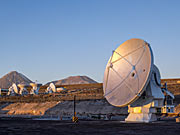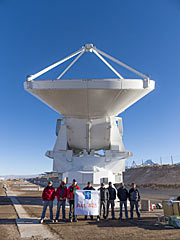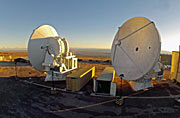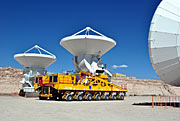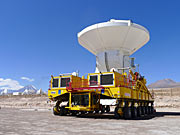Comunicato Stampa
Consegnata l'ultima antenna di ALMA
Tutte e 66 le antenne di ALMA sono state consegnate all'Osservatorio
01 Ottobre 2013
L'antenna finale del progetto ALMA (Atacama Large Millimeter/submillimeter Array) è stata appena consegnata all'Osservatorio. La parabola da 12 metri di diametro è stata prodotta dal consorzio europeo AEM e segna il successo della fornitura di un totale di 25 antenne europee - finora il più grande contratto dell'ESO.
L'antenna è la numero 66, l'ultima da consegnare all'Osservatorio. Il Nord America ha fornito 25 antenne da 12 metri, mentre l'Asia Orientale 16 (quattro da 12 metri e dodici da 7 metri di diametro). Entro la fine del 2013 tutte le 66 antenne radio super-precise per la banda millimetrica e submillimetrica dovrebbero funzionare insieme come un unico telescopio, in una schiera che potrà distendersi per 16 chilometri nella Piana di Chajnantor nel Deserto di Atacama nel nord del Cile.
L'Osservatorio ALMA è stato inaugurato dal Presidente del Cile, Sebastián Piñera, nel marzo 2013 (eso1312): l'evento ha segnato il completamento di tutti i sistemi principali dell'enorme telescopio e il passaggio formale da un progetto in costruzione ad un Osservatorio a tutti gli effetti.
La consegna dell'ultima antenna completa la fase di costruzione delle antenne di ALMA [1] e fornisce tutte e 66 le antenne per usi scientifici, segnando l'inizio di una nuova era di scoperte astronomiche. "È un passo fondamentale per l'Osservatorio ALMA poichè perette agli astronomi in Europa e altrove di usare il telescopio ALMA nella sua forma finale, con tutta la sensibilità e l'area di rcaccolta." afferma Wolfgang Wild, il capo progetto europeo di ALMA.
Il trasferimento dell'ultima antenna europea segna il successo del completamento del più grande contratto mai firmato dall'ESO finora. Il contratto con il consorzio AEM [2] copriva il progetto, la costruzione, il trasporto e l'integrazione in sito delle 25 antenne.
ALMA permette agli astronomi di rispondere a domande fondamentali sulle nostre origini cosmiche. Il telescopio osserva l'Universo per mezzo di luce millimetrica e submillimetrica, cioè tra la luce infrarossa e le onde radio nello spettro elettromagnetico. La luce di queste lunghezze d'onda proviene da alcune delle più fredde zone e dei più distanti oggetti nel Cosmo, tra cui le nubi fredde di gas e polvere in cui nascono nuove stelle e le galassie remote al confine dell'Universo osservabile.
L'Universo è relativamente inesplorato a lunghezze d'onda millimetriche e submillimetriche, dal momento che i telescopi hanno bisogno di condizioni atmosferiche molto secche, come quelle che si trovano a Chajnantor, molte grandi antenne e tecnologia all'avanguardia. Anche prima del completamento, ALMA è stato ampiamente usato per progetti scientifici e ha mostrato un grande potenziale con la pubblicazione di notevoli, entusiasmanti, risultati scientifici (si veda eso1136, eso eso1334, eso1333, eso1331, eso1325, eso1318, eso1313 e eso1234).
Note
[1] L'ESO è anche responsabile di tutte le attività di costruzione della Residencia che accoglierà il personale ospite.
[2] Il Consorzio AEM è composto da Thales Alenia Space, European Industrial Engineering, e MT-Mechatronics.
Ulteriori Informazioni
ALMA, l'Atacama Large Millimeter/submillimeter Array, una struttura osservativa astronomica internazionale, è costruita in partnership tra Europa, Nord America e Asia Orientale in cooperazione con la Repubblica del Cile. La costruzione e la gestione di ALMA sono condotte dall'ESO per conto dell'Europa, dall'NRAO (National Radio Astronomy Observatory) per conto del Nord America e dal NAOJ (National Astronomical Observatory of Japan) per conto dell'Asia Orientale. Il JAO (Joint ALMA Observatory) garantisce una guida e gestione unica alla costruzione, alla verifica e alla gestione di ALMA.
L'ESO (European Southern Observatory, o Osservatorio Australe Europeo) è la principale organizzazione intergovernativa di Astronomia in Europa e l'osservatorio astronomico più produttivo al mondo. È sostenuto da 15 paesi: Austria, Belgio, Brasile, Danimarca, Finlandia, Francia, Germania, Gran Bretagna, Italia, Olanda, Portogallo, Repubblica Ceca, Spagna, Svezia, e Svizzera. L'ESO svolge un ambizioso programma che si concentra sulla progettazione, costruzione e gestione di potenti strumenti astronomici da terra che consentano agli astronomi di realizzare importanti scoperte scientifiche. L'ESO ha anche un ruolo di punta nel promuovere e organizzare la cooperazione nella ricerca astronomica. L'ESO gestisce tre siti osservativi unici al mondo in Cile: La Silla, Paranal e Chajnantor. Sul Paranal, l'ESO gestisce il Very Large Telescope, osservatorio astronomico d'avanguardia nella banda visibile e due telescopi per survey. VISTA, il più grande telescopio per survey al mondo, lavora nella banda infrarossa mentre il VST (VLT Survey Telescope) è il più grande telescopio progettato appositamente per produrre survey del cielo in luce visibile. L'ESO è il partner europeo di un telescopio astronomico di concetto rivoluzionario, ALMA, il più grande progetto astronomico esistente. L'ESO al momento sta progettando l'European Extremely Large Telescope o E-ELT (significa Telescopio Europeo Estremamente Grande), un telescopio da 39 metri che opera nell'ottico e infrarosso vicino e che diventerà "il più grande occhio del mondo rivolto al cielo".
La traduzione dall'inglese dei comunicati stampa dell'ESO è un servizio dalla Rete di Divulgazione Scientifica dell'ESO (ESON: ESO Science Outreach Network) composta da ricercatori e divulgatori scientifici da tutti gli Stati Membri dell'ESO e altri paesi. Il nodo italiano della rete ESON è gestito da Anna Wolter.
Links
Contatti
Wolfgang Wild
European ALMA Project Manager, ESO
Garching bei München, Germany
Tel.: +49 89 3200 6716
E-mail: wwild@eso.org
Stefano Stanghellini
ALMA Antenna Project Manager, ESO
Garching bei München, Germany
Tel.: +49 89 3200 6570
E-mail: sstanghe@eso.org
Richard Hook
ESO, Public Information Officer
Garching bei München, Germany
Tel.: +49 89 3200 6655
Cell.: +49 151 1537 3591
E-mail: rhook@eso.org
Anna Wolter (press contact Italia)
Rete di divulgazione scientifica dell'ESO
e INAF-Osservatorio Astronomico di Brera
Milano, Italy
Tel.: +39 02 72320321
E-mail: eson-italy@eso.org
Sul Comunicato Stampa
| Comunicato Stampa N": | eso1342it |
| Nome: | Atacama Large Millimeter/submillimeter Array |
| Tipo: | Unspecified : Technology : Observatory : Facility |
| Facility: | Atacama Large Millimeter/submillimeter Array |
Our use of Cookies
We use cookies that are essential for accessing our websites and using our services. We also use cookies to analyse, measure and improve our websites’ performance, to enable content sharing via social media and to display media content hosted on third-party platforms.
ESO Cookies Policy
The European Organisation for Astronomical Research in the Southern Hemisphere (ESO) is the pre-eminent intergovernmental science and technology organisation in astronomy. It carries out an ambitious programme focused on the design, construction and operation of powerful ground-based observing facilities for astronomy.
This Cookies Policy is intended to provide clarity by outlining the cookies used on the ESO public websites, their functions, the options you have for controlling them, and the ways you can contact us for additional details.
What are cookies?
Cookies are small pieces of data stored on your device by websites you visit. They serve various purposes, such as remembering login credentials and preferences and enhance your browsing experience.
Categories of cookies we use
Essential cookies (always active): These cookies are strictly necessary for the proper functioning of our website. Without these cookies, the website cannot operate correctly, and certain services, such as logging in or accessing secure areas, may not be available; because they are essential for the website’s operation, they cannot be disabled.
Functional Cookies: These cookies enhance your browsing experience by enabling additional features and personalization, such as remembering your preferences and settings. While not strictly necessary for the website to function, they improve usability and convenience; these cookies are only placed if you provide your consent.
Analytics cookies: These cookies collect information about how visitors interact with our website, such as which pages are visited most often and how users navigate the site. This data helps us improve website performance, optimize content, and enhance the user experience; these cookies are only placed if you provide your consent. We use the following analytics cookies.
Matomo Cookies:
This website uses Matomo (formerly Piwik), an open source software which enables the statistical analysis of website visits. Matomo uses cookies (text files) which are saved on your computer and which allow us to analyze how you use our website. The website user information generated by the cookies will only be saved on the servers of our IT Department. We use this information to analyze www.eso.org visits and to prepare reports on website activities. These data will not be disclosed to third parties.
On behalf of ESO, Matomo will use this information for the purpose of evaluating your use of the website, compiling reports on website activity and providing other services relating to website activity and internet usage.
Matomo cookies settings:
Additional Third-party cookies on ESO websites: some of our pages display content from external providers, e.g. YouTube.
Such third-party services are outside of ESO control and may, at any time, change their terms of service, use of cookies, etc.
YouTube: Some videos on the ESO website are embedded from ESO’s official YouTube channel. We have enabled YouTube’s privacy-enhanced mode, meaning that no cookies are set unless the user actively clicks on the video to play it. Additionally, in this mode, YouTube does not store any personally identifiable cookie data for embedded video playbacks. For more details, please refer to YouTube’s embedding videos information page.
Cookies can also be classified based on the following elements.
Regarding the domain, there are:
- First-party cookies, set by the website you are currently visiting. They are stored by the same domain that you are browsing and are used to enhance your experience on that site;
- Third-party cookies, set by a domain other than the one you are currently visiting.
As for their duration, cookies can be:
- Browser-session cookies, which are deleted when the user closes the browser;
- Stored cookies, which stay on the user's device for a predetermined period of time.
How to manage cookies
Cookie settings: You can modify your cookie choices for the ESO webpages at any time by clicking on the link Cookie settings at the bottom of any page.
In your browser: If you wish to delete cookies or instruct your browser to delete or block cookies by default, please visit the help pages of your browser:
Please be aware that if you delete or decline cookies, certain functionalities of our website may be not be available and your browsing experience may be affected.
You can set most browsers to prevent any cookies being placed on your device, but you may then have to manually adjust some preferences every time you visit a site/page. And some services and functionalities may not work properly at all (e.g. profile logging-in, shop check out).
Updates to the ESO Cookies Policy
The ESO Cookies Policy may be subject to future updates, which will be made available on this page.
Additional information
For any queries related to cookies, please contact: pdprATesoDOTorg.
As ESO public webpages are managed by our Department of Communication, your questions will be dealt with the support of the said Department.

